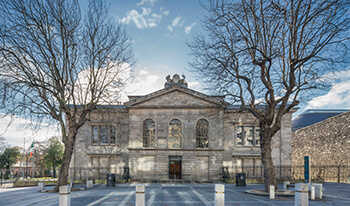Powerscourt Estate is located near Enniskerry, County Wicklow, Ireland, is a large country estate which is noted for its house and landscaped gardens, today occupying 19 hectares (47 acres). The house, originally a 13th century castle, was extensively altered during the 18th century by German architect Richard Cassels, starting in 1731 and finishing in 1741. A fire in 1974 left the house lying as a shell until it was renovated in 1996.
The estate is today owned and run by the Slazenger family. It is a popular tourist attraction, and includes a golf course, an Avoca Handweavers restaurant, and a Ritz-Carlton hotel.
The original owner of the 13th century castle was a man by the name of la Poer, which was eventually anglicised to Power. The castle's position was of strategic military importance, in that the castle's owner could control access to the nearby Dargle, Glencree and Glencullen rivers.
The three-story house had at least 68 rooms. The entrance hall was 18 metres (60 ft) long and 12 metres (40 ft) wide where family heirlooms were displayed. The main reception rooms were on the first floor rather than more typically on the ground floor. A mile-long avenue of beech trees leads to the house.
Powerscourt House was extensively altered during the 18th century by German architect Richard Cassels, starting in 1731 and finishing in 1741.
King George IV was the guest of Richard Wingfield, fifth Viscount Powerscourt in August 1821. In the 1830s, the house was the venue for a number of conferences on unfulfilled Bible prophecies, which were attended by men such as John Nelson Darby and Edward Irving. These conferences were held under the auspices of Theodosia Wingfield Powerscourt, then the dowager Lady Powerscourt. Her letters and papers have recently been republished together with the summaries of the Powerscourt prophetic conferences.
Mervyn Wingfield, seventh Viscount Powerscourt, inherited the title and the Powerscourt estate, which comprised 200 km2 (49,000 acres) of land in Ireland, at the age of 8 in 1844. When he reached the age of 21, he embarked on an extensive renovation of the house and created new gardens.
Inspiration for the garden design followed visits by Powerscourt to ornamental gardens at the Palace of Versailles, Schönbrunn Palace near Vienna, and Schwetzingen Castle near Heidelberg. The garden development took 20 years to complete in 1880.
Main attractions on the grounds include the Tower Valley (with stone tower), Japanese gardens, winged horse statues, Triton Lake, pet cemetery, Dolphin Pond, walled gardens, Bamberg Gate and the Italian Garden. The Pepperpot Tower is said to be designed after a favored 3" pepperpot of Lady Wingfield. Of particular note is the pets cemetery, whose tombstones have been described as "astonishingly personal".
The house was destroyed by fire on 4 November 1974, while it was owned by the Slazenger family, and was subsequently renovated in 1996. Only two rooms are open to the public as they once appeared while Powerscourt had residents, while the rest of ground floor and first floor are now retail units.
Tours featuring this attraction
Peace of Mind Guarantee
Your trip, worry free!Our Ireland based team is on call throughout your vacation!

